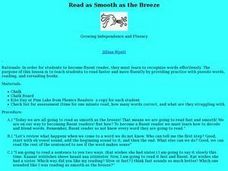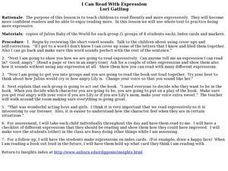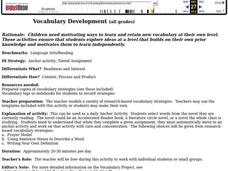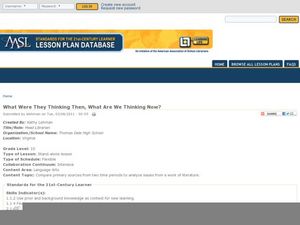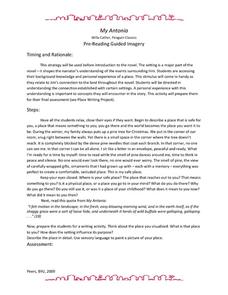Curated OER
Express Your Reading
Students increase their reading fluency and reading expression through the use of various strategies. After reviewing decoding and rereading, students complete an initial read of a novel text without expression. Working with a partner,...
Curated OER
On Your Mark, Get Set, Read
Students increase their reading fluency through the use of various strategies. After reviewing chunking, decoding, and rereading, students complete an initial read of a novel text. Working with the instructor, they read complete a timed...
Curated OER
Ready, Set, Read
Learners increase their reading fluency through the use of various strategies. After reviewing chunking and rereading, students complete an initial read of a novel text. They record their word count on a progress chart after timed read.
Curated OER
Read as Smooth as the Breeze
Student increase their reading fluency through the use of various strategies. After reviewing decoding strategies, students complete an initial read of a novel text. Working with the instructor, they complete a timed assessment of their...
Curated OER
I Can Read With Expression
Students practice reading fluently and expressively through the use of various strategies. After reviewing chunking, decoding, and rereading, students complete an initial read of a novel text. They create a deck of expression cards to...
Minnesota Literacy Council
Grapes of Wrath and Pronouns
Many regard John Steinbeck's The Grapes of Wrath as the great American novel. The lesson plan combines a variety of strategies, including partner work, independent practice, creative writing, grammar instruction, and small group...
Curated OER
Shizuko's Daughter: Concept of Definition Word Map
Help your class use critical thinking when it comes to unfamiliar words. With vocabulary from Kyoko Mori's Shizuko's Daughter, kids write the word in the center of a graphic organizer, and find its category, comparisons,...
Curated OER
Vocabulary Development
Learners utilize various vocabulary strategies. They use vocabulary logs to record strategies they have been taught, such as the Frayer Model (definition, picture, examples, non-examples), writing their own definitions, and using...
Curated OER
Running Out of Time: Picture Book Activity
Ease your class into reading Running Out of Time by first reading The Boy Who Stopped Time, a picture book with some similar concepts and themes. After a reading of the story, learners participate in a discussion and journaling exercise.
Curated OER
What Were They Thinking Then, What Are We Thinking Now?
Choosing an issue from a play or novel, researchers find two primary sources from different time periods to compare how people's views have changed. Many questions are listed to guide young writers. In the end, learners produce a...
Curated OER
Hoot: Anticipation Guide
Should companies be able to build wherever they want? Are animals worth protecting? Explore the literary themes from Carl Hiaasen's Hoot with an anticipation guide. Kids read ten statements and decide if they agree or disagree, then...
Novelinks
The Heart Is a Lonely Hunter: Vocabulary List
A staggering amount of work went into compiling this vocabulary resource for Carson McCullers' The Heart Is a Lonely Hunter. The overview provides a rationale for the strategy and information about tier 1, 2, and 3 words. The...
Brigham Young University
Socratic Seminar for Cold Sassy Tree
Tired of giving the same old multiple-choice tests, and have the urge for a new assessment? Then bring the precision of a Socratic seminar into your classroom. Even if you did not read Cold Sassy Tree the organization and explanation on...
Novelinks
The Hobbit: Biopoem
As part of their reading of The Hobbit, readers create a biopoem for one of Tolkien's characters.
Curated OER
Flipped: After Reading Strategy
Everyone can be an expert! After finishing Wendelin Van Draanen's book Flipped, divide your class into small groups. Then, assign each group a topic to become experts on. The resource suggests topics such as characters, themes, setting,...
Novelinks
The Little Prince: Picture Book Strategy
Picture books aren't just for children; they carry strong, valuable messages for adult as well. Explore the audience for Antoine de Saint-Exupéry's The Little Prince with a instructional activity that compares picture books to...
Curated OER
The Catcher in the Rye: Vocabulary Self-Collection Strategy
Group members select a word from The Catcher in the Rye they would like the class to know more about. After identifying the context and determining the meaning of the word from the context, they present the word to the entire class,...
Novelinks
The House on Mango Street: Discussion Web
As part of a final discussion of The House on Mango Street, groups examine a concept question about the text, record arguments for and opposed to the question, and then a draw their own conclusions.
Curated OER
My Antonia: Prereading Guided Imagery
What makes a place safe? What makes a setting effective? Explore the safe spaces and descriptive language with a prereading activity for Willa Cather's My Antonia. The teacher describes his or her own safe space and then prompts pupils...
Bantam Books
The Tempest: Chalk Talk
Discussion doesn't always need to be spoken. Before you begin The Tempest by William Shakespeare, have kids connect their ideas and experiences to central questions of the play with a silent discussion activity. Once they have...
Novelinks
The Heart Is a Lonely Hunter: Anticipation Guide
Get readers thinking about issues raised by Chapter 5 of Carson McCullers' The Heart Is a Lonely Hunter with an anticipation guide. Individuals decide whether they agree or disagree with a series of statements and discuss their...
For the Teachers
Sequence Plot Chart
Your kids can identify the plot sequence of a short story, but what about an informational article? Have them examine the chronological order of events in informational texts with a lesson on the sequence of events.
Curated OER
The Giver: Lesson 1
Do “memories need to be shared?" Are “memories…forever?" Would you give up memory to live in a perfect world? Introduce a unit centered on Lois Lowry’s utopian/dystopian novel The Giver with a series of activities that has groups...
EngageNY
Analyzing Point of View and Figurative Language: Chapter 1
Check out the view! Scholars complete a graphic organizer to analyze how Laurence Yep develops a character's point of view in Dragonwings. Additionally, pupils re-read parts of the novel and annotate the text on sticky notes, looking for...



